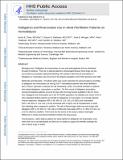Dabigatran and Rivaroxaban Use in Atrial Fibrillation Patients on Hemodialysis
Author(s)
Chan, Kevin E.; Edelman, Elazer R.; Wenger, Julia B.; Thadhani, Ravi I.; Maddux, Franklin W.
DownloadEdelman_Dabigatran and.pdf (411.0Kb)
OPEN_ACCESS_POLICY
Open Access Policy
Creative Commons Attribution-Noncommercial-Share Alike
Terms of use
Metadata
Show full item recordAbstract
Background—Dabigatran and rivaroxaban are new oral anticoagulants that are eliminated through the kidneys. Their use in dialysis patients is discouraged because these drugs can bioaccumulate to precipitate inadvertent bleeding. We wanted to determine whether prescription of dabigatran or rivaroxaban was occurring in the dialysis population and whether these practices were safe.
Methods and Results—Prevalence plots were used to describe the point prevalence (monthly) of dabigatran and rivaroxaban use among 29 977 hemodialysis patients with atrial fibrillation. Poisson regression compared the rate of bleeding, stroke, and arterial embolism in patients who started dabigatran, rivaroxaban, or warfarin. The first record of dabigatran prescription among hemodialysis patients occurred 45 days after the drug became available in the United States. Since then, dabigatran and rivaroxaban use in the atrial fibrillation–end-stage renal disease population has steadily risen where 5.9% of anticoagulated dialysis patients are started on dabigatrian or rivaroxaban. In covariate adjusted Poisson regression, dabigatran (rate ratio, 1.48; 95% confidence interval, 1.21–1.81; P=0.0001) and rivaroxaban (rate ratio, 1.38; 95% confidence interval, 1.03–1.83; P=0.04) associated with a higher risk of hospitalization or death from bleeding when compared with warfarin. The risk of hemorrhagic death was even larger with dabigatran (rate ratio, 1.78; 95% confidence interval, 1.18–2.68; P=0.006) and rivaroxaban (rate ratio, 1.71; 95% confidence interval, 0.94–3.12; P=0.07) relative to warfarin. There were too few events in the study to detect meaningful differences in stroke and arterial embolism between the drug groups.
Conclusions—More dialysis patients are being started on dabigatran and rivaroxaban, even when their use is contraindicated and there are no studies to support that the benefits outweigh the risks of these drugs in end-stage renal disease.
Description
available in PMC 2016 March 17
Date issued
2015-01Department
Massachusetts Institute of Technology. Institute for Medical Engineering & Science; Harvard University--MIT Division of Health Sciences and TechnologyJournal
Circulation
Publisher
American Heart Association
Citation
Chan, Kevin E., Elazer R. Edelman, Julia B. Wenger, Ravi I. Thadhani, and Franklin W. Maddux. "Dabigatran and Rivaroxaban Use in Atrial Fibrillation Patients on Hemodialysis." Circulation. 2015; 131: 972-979.
Version: Author's final manuscript
ISSN
0009-7322
1524-4539